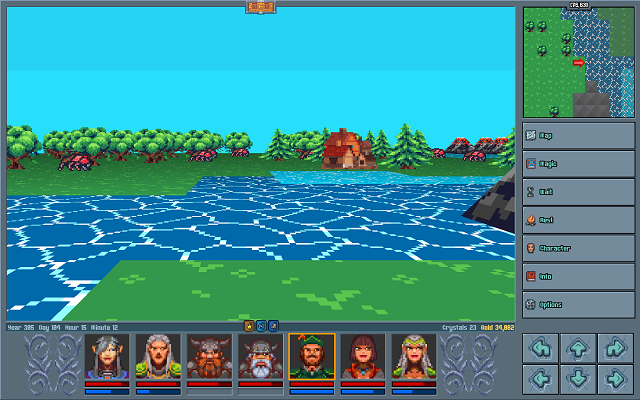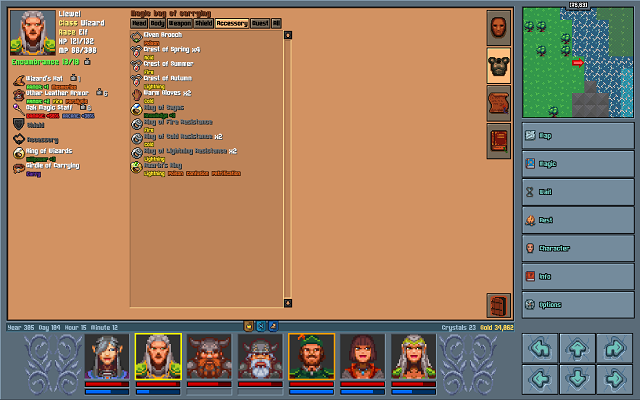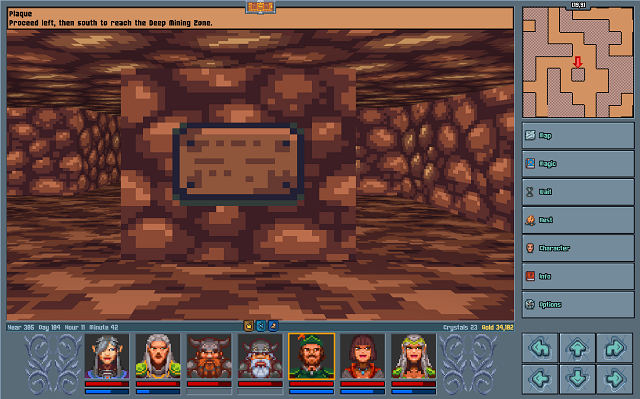
Legends of Amberland is a very traditional indie CRPG that was released on Steam last year and has now found its way to GOG (which is how I noticed it). TL;DR: If the screenshots in this posting trigger any kind of positive memory in you, buy the game; it may not be perfect, but will still easily be good for 20-30 hours of old-school fun, depending on your playstyle.
If you are looking for a thorough review from a player’s perspective, you should also have a look here. This review, as my previous ones, will focus on my perspective as a fellow indie CRPG designer. Onwards!
The World of Xeen (Might & Magic parts IV & V) has had a huge influence on me, in terms of both what I want to play and what I want to design. Unfortunately, grid-based movement went out of fashion somewhen in the last millennium, and the renaissance started with Legend of Grimrock only covers the Dungeon Master-style games, meaning real-time combat, usually no overland exploration, no NPC interaction and so on. Eventually, I would accept the fact that Might & Magic X: Legacy had probably been the last of its kind, which is bad because I’m really not that good at dexterity-based combat. But if I wanted another game that followed its foot-steps, I’d probably have to create it myself. Haha, alright, we’ll meet in 2040.
Well, along comes the GOG newsletter that tells me of Legend of Amberland. This title basically screams “Might & Magic III-V” right from the start – so much so that whenever I refer to “Might & Magic” in the rest of this posting, please assume it refers to these three games. The pixel graphics, the mood, the tents with quest-givers, everything seems quite familiar. The adherence to MM III in particular goes so far that even the layout of the game world is somewhat similar to the Isles of Terra, except it’s bigger. However, because of this high similarity, the lack of certain gameplay elements becomes all the more obvious.
I’m not going to talk a lot about the presentation. The graphics are really pixel-y, but they are sufficient to convey a feeling of the landscape you are exploring and the monsters you are facing. Let’s be honest, Xeen and Terra didn’t do much else; the mountains never really looked like mountains and the monsters, although they boasted fluid animations, also were kinda goofy.

Same goes for the sound, which is adequate, and the interface, which could use more mouse/keyboard redundancy, but is perfectly serviceable. Instead, let’s go to the meat: Game mechanics and design.
The Might & Magic games were always a blend of exploration, puzzles, party development and combat (with story and NPC interaction really on the backseat). Of these, combat is the easiest to tackle. Combat decisions in Might & Magic are mostly made on the strategical rather than the tactical level, meaning that character development, equipment, spell selection and buffing matter more than the in-combat decisions. Even for high-level spellcasters with bloated spellbooks, it is usually quite obvious which one to cast in any given situation, making decisions rather easy. This results in very fast-paced individual combats, especially for turn-based games. Amberland follows this path closely: Except for a special ability for each character class like the ranger’s “Stun” attack, which can be activated once per rest, it adds nothing to the known formula.
These fast-paced combats, though, are part of what puts you into a “flow”, so to speak: I can always do one more combat, right? Still, I would have liked to see a few more elements on the strategical level that would have allowed for more experimentation and diversity, because even if you can always do one more combat, it has a tendency to get tiresome after like the 127th killed troll in a row, not to mention genocidal. Lords of Xulima, for instance, introduced various types of ongoing damage, which would make the choice between a more-damage-once and less-damage-ongoing weapon interesting. Or how about heavy weapons that generally have a chance to stun, but a lower chance to hit? Spells that nerf monsters, reducing their armor, chance to hit, ability to deal special damage, and so on – generally, more varied approaches would have been nice.
Party development has always been special in the Might & Magic games because of its massive dimensions. The standard character level range in CRPGs is about 1-20, as decreed by the grandfather AD&D, but in Might & Magic, our characters will advance to level 50, level 100 or even higher (I think I managed to end a Xeen playthrough with a level 250 orcish fighter). During the course of the game, the characters will also receive similarly over-the-top stat bonuses, so in the end we’ll have a sorcerer with an intelligence of 350 and 5,000 spell points. Of course, the game always finds equally ridiculous monsters that still manage to one-shot our buffed-up super heroes. I guess that’s what you sign up for when you want to save a fantasy world.
In Amberland, characters advance to about level 50. Leveling happens at a brisk pace, even at “Hard” mode (I didn’t try “Insane”), but the only decision it asks for is the distribution of a single stat point every few levels. Non-magic users don’t gain any new abilities at all; spellcasters automatically acquire a few spells every few levels, so unlike in Might & Magic there’s no need to save money to purchase them, to make choices who gets which spells, to find some in dungeons; neither are there secondary skills like Pathfinder or Swimming to acquire. While I’m at it, let me take a short look at equipment as well: It’s a little underwhelming, the difference in power between the starting items and the endgame items isn’t all that high. The main use for items is providing your heroes with magical resistances, since there are no buffing spells that do this.

The developer has stressed that he wanted to cut out all the “boring” parts out of the game, which in his opinion includes the standard haul-loot-to-shop marathon that CRPG players have come to accept as a standard. I absolutely agree with the intention to streamline the gameplay, but in this case it comes with a high cost: I think acquiring ever more powerful equipment for your character is a massively motivating game element, and the loot-to-shop cycle is just an inevitable byproduct. I simply missed outfitting my characters with steel, ruby and finally obsidian armors, just as I missed boosting their character stats to stratospheric levels. And again, it takes away a field of decisions from the game (do I save my money for a super weapon or do I purchase some smaller upgrades right now? if it’s the super weapon, who gets to wield it? do I concentrate the toughness bonuses on my primary warrior to make him an ultra-tank or do I toughen up everyone a bit by spreading things out? etc…).
Speaking of spreading out, I’m not sure about the party size of seven characters (they were six in Might & Magic), in particular because the developer also chose to omit the rogue classes. That’s only natural because of the game’s lack of interaction points that would have allowed to rogue to shine (we’ll get to that), but it leaves only three roles for a character to specialize in: melee fighter, arcane spellcaster, divine spellcaster. When creating the party, I was filled with the unusual dilemma of too few options; I take three specialists, three “hybrids” like rangers (melee fighter/arcane spellcaster) and still have a slot leftover. With so few areas to cover, there’s also little motivation to start another run with a different party composition. I think five characters would have sufficed, although it’s entirely possible that I’m simply missing the intention here.
Puzzles… well, unfortunately, Amberland has none. If there’s a lever, it will predictably open a locked door two rooms further. That’s it. No secret doors, no word puzzles, no lever combinations, no teleport traps or whatever you might think of (see here). In fact, except for levers with obvious uses, healing wells, treasure chests and crystal stands, the many, many dungeons of Amberland don’t feature any interactive objects at all. I’m not sure if the developer counts actual puzzles among the “boring parts” of CRPGs, but if you don’t want puzzles, at least think about interaction points, i.e. environmental features that are more than just decoration – how about coffins that hold vast treasures but also powerful vampires and liches? Statues that demand a sacrifice to open a way, maybe an alternate way that would allow bypassing a hallway filled with deadly traps and powerful enemies? Altars of dark gods that give XP when destroyed, but also curse the party (maybe regularly until a healer in a town has lifted the curse, which requires yet another quest)? A tome that rewards the reader with numerous XP or a Knowledge stat bonus, but looks like gibberish until read with the proper glasses? None of these require much thinking by the player, but they do demand a decision, and interesting decisions make a game more fun. I was a little disappointed to find the game lacking in this regard, especially since the Might & Magic games did their best to give each location its own peculiarities. In the end, this also affects the last point on the list:
Exploration, Amberland‘s main virtue. And here, the game fires on all cylinders. At 120×100, i.e. 12,000 squares, the overworld is nearly as large as both parts of Xeen put together (each 64×96 = 6,144 squares). I haven’t counted out all the dungeons, but Amberland has a lot of them; although many of them aren’t all that large and only few have multiple levels, I’m sure they can at least rival any single Might & Magic game. We have a variety of terrain types, both overland and in the dungeons (with castles, towers, caverns, ice caverns, slime caverns all having different visuals).

However, the crux is that while there’s a lot to explore in Amberland, there’s not all that much to discover. The different environments and monsters are sufficient to maintain a basic curiosity. And there are dungeons and tents around each corner, which is cool. But in the dungeons, all we find are monsters and a final treasure trove, with maybe a prisoner in the last corner. This gets old after a while. In rare cases, there are hints of something bigger, but they remain hints. For instance, at the end of one dungeon I found a chamber that contained a handful of entombed kings. Sadly, except for a small bit of lore, there was nothing to do with them. Loot them? Fight dead kings at your own risk? Talk with them (if you wield the Necromantic Scepter) and get a secret quest to bring the forgotten crown, around which the main quest revolves, to them instead of the (living) human king? Unfortunately, no such things.
Similarly, in Terra and Xeen, making it to a new city always came with big excitement – a new guild with new spells, new shops with new items, training grounds for higher levels and so on. In Amberland, every city is a simple menu screen that offers the exact same items and services, and since there’s a griffin fast-travel that can instantly teleport you anywhere you’ve ever been, I’m not sure why there even is more than one city. With measures like these, the game undercuts its own sense of discovery and thus its greatest strength.
I am absolutely aware that it’s impossible for what is essentially a one-man developer to incorporate each and any idea that comes to mind. “You can only include what you can pay”, and at some point, you pay with time. It’s more that I would definitely have preferred a few dungeons less, but more memorable interaction points in the remaining ones (and judging from the other reviews around the web, I’m not the only one).
All of this is not to say that Legends of Amberland is a bad game, far from it (see the TL;DR)! The fact that there are basically no loading screens, few distracting routine maintenance tasks and that you rarely agonize over difficult decisions means that there’s a powerful “flow” carrying you right from start to end, just like in the old times. But besides all the bloody combat meat on this beautiful porcellaine exploration plate, I’d have liked some side orders of loot, more interaction vegetables and finally some spicy puzzles for the satisfying experience of a whole meal. Despite the whole thing being quite sizable, I can’t help but feel it was just the starters course. Still, since this special taste has not been on the menu for a long while, anyone interested should give it at least a try; you’ll get your money’s worth in fun.
And then go and wait for part II.
(Addendum: Is there any developer out there who could combine Amberland‘s engine with the capabilities of the Dark Disciples II event editor? That could make for one helluva project – a five-star, seven-course menu, if you so will. Is it all that difficult? Anyone?)
